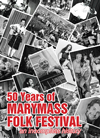
PETE HEYWOOD - 50 Years of Marymass Folk Festival: An Incomplete History
Traditional Arts Development ISBN: 9781838294236
This book does exactly what it says on the tin and celebrates 50 Years of Marymass Folk Festival - interpreted as synonymous to Irvine Folk Club, the flourishing nurse-bed of the Festival - and, with the subtitle, expresses the hope of more to come. It’s lavishly illustrated, and some of the rare and unseen pictures are equal to the proverbial thousand words, like teacher Adam McNaughtan with two young charges and Hamish Imlach with a wee girl skipping (it’s his daughter Vhari), or the High Level Ranters smoldering under the High Level Bridge in Newcastle. Malky McCormick’s cheerful cartoons are a gift to any picture editor.
Let’s see, a 50-year rewind takes us back to (quick calculation) the late 60s. An auspicious period, when everyone was hairy, vigorous and youthful, ushering in the messy, misunderstood and optimistic seventies, when surprising things happened. Not coincidentally, it was a great period for music. The spirit lingers in Marymass Folk Festival, shaped by Irvine’s special character as a new town with an ancient past. The original Marymass Fair was a 10-day spree from the 12th century. It survives to this day without the religious trappings, and the Folk Festival is a parallel event with direct overlap – folk musicians often accompany the crowning of the Marymass Queen. The strong community roots attest to the resourcefulness of long-time organiser, Stan Robertson, one of the architects of Irvine New Town.
Not only musicians and organisers, but pub landlords, astronomers and other larger-than life characters get their due in the Incomplete History. These categories are not mutually exclusive, of course.
Duncan Lunan approached Irvine Town Council and the Traditional Music & Song Association to fund a folk festival in Irvine in 1967. His proposal was turned down by the council as too traditional and rejected by the Association because it wasn’t traditional enough. Chapter 2, about the early years of Irvine Folk Song Club, drops subtle clues about Lunan’s related obsessions: the outing by club members to Glasgow to see 2001: A Space Odyssey, and an intriguing aside about being stranded in the USA for months when the organisers of his lecture tour went bankrupt. Lunan, as well as being a charter member of the Irvine Folk Song Club, is the founder of ASTRA (the Association in Scotland to Research into Astronautics), pens science fiction and supervised the construction of Sighthill Park, the first astronomically aligned stone circle in Britain in 3,000 years. Clearly, Lunan carries the folk instinct to commemorate bygone times to cosmic extremes.
We knew that Hamish Imlach was a colourful character, but Marymass Folk Festival informs that Butch Cassidy and the Sundance Kid robbed his paternal grandmother’s sister’s Patagonian silver mines. His Calcutta birthplace is unexpected, but the geography of birth is largely happenstance – elsewhere we learn that Dick Gaughan was born in Glasgow. Calcutta, however, set the surreal tone of a life marked by gargantuan excess and generosity. Hamish the songster was fêted in song by Iain MacKintosh in I Wouldn’t Change A Thing: “Takes three men to fill his trousers, but no one fills his shoes.”
Artists’ biographies are dropped into the narrative in boxed, blue pages, so that it resembles a reference work unrestricted by alphabetical order or chronology. The book is far advanced by the time Archie Fisher, the pathfinder of Scottish folk, gets a biographical sketch. Perhaps Archie, no stranger to Marymass, was content to remain in the background. Enigma enhances his artistry: “impressive yet understated” writes the author in praise. We learn how Archie came off worst from the professional split with sister Ray, after she married Colin Ross and moved to Whitley Bay. According to Ray: “I came away with all our repertoire, leaving him with a hundred and fifty harmonies and chord sequences in his head.” Such insight can only be got from the source. Our Marymass guide is an informed insider and on more than nodding terms with musicians. This is inevitable, given the companionable, egalitarian nature of a tight-knit scene. It follows that music is foremost a live experience. The few factual errors I spotted stem from the author’s hazy recollection of old records: Gerry Rafferty was not present on the Humblebums’ debut; Archie Fisher’s eponymous solo was not followed by Will Ye Gang, Love but Orfeo, not counting a couple of Barbara Dickson collaborations in-between. Nitpicking, I say, as someone who relies overmuch on records and is distant from the action.
But say, who wrote the book? We’re not told. My best guess is Pete Heywood, but he will only admit to the foreword, and is mentioned in the third person whenever he makes an appearance. If multiple hands are responsible, none are identified, except Chapter 2 by the aforementioned Duncan Lunan. So, is anonymity a Scottish tradition in itself? (I’m thinking of those ego-free monuments to satirical invective, Ding Dong Dollar and Scots Wha Hae Nae.) Also admirable is the anonymous scribe’s indifference to stardom. Danny Kyle gets top billing over Billy Connolly in their shared entry: international celebrity cuts no ice among old muckers. In similar manner, unsung heroes like Mike Whellans, Adam McNaughtan and The Buskers are given equal status to household names like Aly Bain, Dick Gaughan and Planxty. Yes, but the fun and nostalgia is underpinned by the notion that this is an area worthy of serious study. Inside a big book about a small subject – a festival and a folk club – there is a small book about a big subject struggling to get out: nothing less than the history of the Scottish folk revival.
www.thetraditionbearers.co.uk/shop
Mike Butler
This review appeared in Issue 137 of The Living Tradition magazine
